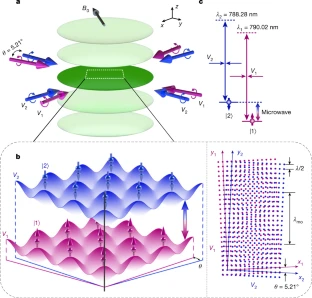Phys.org March 21, 2023
In strong correlations and superconductivity in twisted-bilayer graphene the superposition of two twisted honeycomb lattices generating a moiré pattern is the key to the observed flat electronic bands, slow electron velocity and large density of states. An international team of researchers (USA – University of Chicago, China) demonstrated quantum simulation of superfluid to Mott insulator transition in twisted-bilayer square lattices based on atomic Bose–Einstein condensates loaded into spin-dependent optical lattices. The lattices are made of two sets of laser beams that independently address atoms in different spin states, which form the synthetic dimension accommodating the two layers. The interlayer coupling is highly controllable by a microwave field, which enables the occurrence of a lowest flat band and new correlated phases in the strong coupling limit. They observed the spatial moiré pattern and the momentum diffraction, which confirmed the presence of two forms of superfluid and a modified superfluid to insulator transition in twisted-bilayer lattices. According to the researchers the scheme is generic and can be applied to different lattice geometries and for both boson and fermion systems. This opens new direction for exploring moiré physics in ultracold atoms with highly controllable optical lattices… read more. TECHNICAL ARTICLE

Simulation of twisted-bilayer systems based on atoms in spin-dependent optical lattices. Credit: Nature volume 615, pages 231–236 (2023)